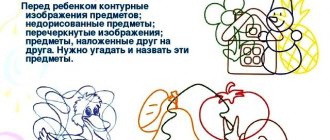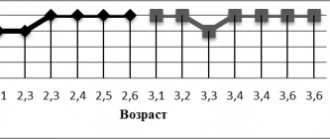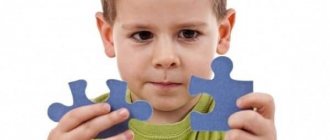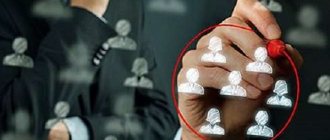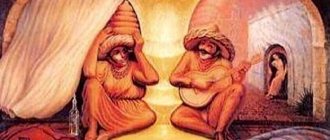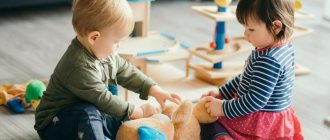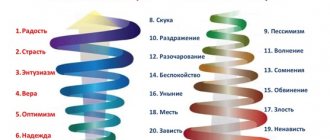The mental development of a child is a very complex, subtle and lengthy process, which is influenced by many factors.
An idea of how this or that stage goes will help you not only better understand your child, but also notice developmental delays in time and take appropriate measures. The generally accepted periodization of the development of the child’s psyche was developed by the Soviet psychologist Daniil Borisovich Elkonin. Even if you have never encountered his works, this system is familiar to you: in the annotations to children's publications it is often indicated that this work is “for preschool age” or “for primary schoolchildren.”
Elkonin’s system describes the mental development of a child from infancy to 15 years, although in some of his works the age of 17 years is indicated.
According to the scientist, the characteristics of each stage of development are determined by the leading activity of the child at a particular age, within the framework of which certain mental new formations appear.
Infancy
This stage covers the period from birth to one year. The leading activity of the baby is communication with significant figures, that is, adults. Mainly mom and dad. He learns to interact with others, express his desires and respond to stimuli in ways accessible to him - intonation, individual sounds, gestures, facial expressions. The main goal of cognitive activity is knowledge of relationships.
The task of parents is to teach the child to “communicate” with the outside world as quickly as possible. Games for the development of large and fine motor skills and the formation of a color scheme will help with this. Among the toys there must be objects of various colors, sizes, shapes, textures. Until one year, the child does not experience any experiences other than natural ones: hunger, pain, cold, thirst, and is not able to learn the rules.
How the nervous system is formed
When a baby is born, its brain weight is about 1/8 of its body weight. By the first year of life, the brain will double in size, and by three years it will already be three times larger than at birth and will be 1/13 of body weight. From here it should be understood that after birth the brain not only does not stop growing, but it continues to actively form. Thus, convolutions, small and large, and grooves are formed. The cerebellum, weak from birth, is actively developing. The immaturity of the newborn's brain, however, does not affect the system of unconditioned reflexes. Innate skills not only help the baby eat and contact the outside world, but also allow him to develop more complex forms of activity in the future. So, from a very early age, the baby will show an undifferentiated nature of reactions. However, the development of the nervous system in the first year of his life will be the fastest and most energetic. Further, the pace of development will be slower, but will acquire a different character and will no longer be aimed at the formation and development of the reflex system, but at the development of mental skills.
Early childhood
It lasts from 1 year to 3 years. The leading activity is manipulative-objective activity. The child discovers many objects around him and strives to explore them as quickly as possible - taste them, break them, etc. He learns their names and makes his first attempts to take part in the conversation of adults.
Mental new formations are speech and visual-effective thinking, that is, in order to learn something, he needs to see how this action is performed by one of the elders. It is noteworthy that at first the child will not play independently, without the participation of mom or dad.
Features of the early childhood stage:
- comprehension of the names and purposes of objects, mastering the correct manipulation of a specific object;
- mastering established rules;
- the beginning of awareness of one’s own “I”;
- the beginning of the formation of self-esteem;
- gradual separation of one’s actions from the actions of adults and the need for independence.
Early childhood often ends with the so-called crisis of 3 years, when the child sees pleasure in disobedience, becomes stubborn, literally rebels against established rules, sharp negative reactions increasingly appear, etc.
Preschool age
This stage begins at 3 years and ends at 7 years. The leading activity for preschoolers is play, or rather, role-playing game, during which children learn relationships and consequences. The personal sphere of the psyche is actively developing. Age-related neoplasms are a need for social significance and activity.
The child can move independently, his speech is understandable to adults, and he often feels like a full participant in communication.
- He understands that all actions and actions have a specific meaning. When teaching, for example, hygiene rules, explain why this is necessary.
- The most effective way to absorb information is through play, so role-playing games should be played every day. In games, you should not use real objects, but their substitutes - the simpler the better for the development of abstract thinking.
- The preschooler experiences an urgent need to communicate with peers and learns to interact with them.
Towards the end of the stage, the child gradually gains independence, is able to determine the cause-and-effect relationship, is able to take responsibility for his actions, and obeys the rules if he sees them as reasonable. He learns good habits, rules of politeness, norms of relationships with others, strives to be useful, and willingly makes contact.
Mental processes in our lives
Throughout life, a person grows, develops, masters new areas of knowledge, acquires the necessary skills, and builds relationships with others. Each of us is unique and unrepeatable. But what is the basis of our individuality?
What are the building blocks of our personality? The answer to these questions can not only satisfy our curiosity, but also help in everyday life. We can influence most mental processes, for example, train attention and memory. But such training is not easy and requires conscious volitional efforts. It is much easier to organize your life based on knowledge about the structure of our mental processes. For example, having information about the properties of memory can reduce the time spent on learning new material and increase the efficiency of memorization.
What about other processes? When learning, the speed of acquiring skills depends on the personality traits of the student
: attention, memory, thinking and imagination. To understand your chosen field, you need to acquire new skills. A professional relies on ready-made solutions developed by others, has a perfect understanding of the variety of techniques necessary for work, and is aware of the latest achievements in his field. The master develops his own ways and methods of work. At all three stages - training, professionalism, mastery - a person is faced with the need to master new information, develop new skills, and respond to changes. To always stay “in shape” you need to take care of yourself and use your abilities most effectively.
As for relationships with other people, knowledge of the structure of psychological defenses significantly saves nerves when communicating with others and allows you to better understand yourself. For example, that it’s not “the grapes are sour,” but “I can’t reach it.” The action of psychological defenses is based on the same mental processes, which will be discussed below.
Higher mental processes include
: perception, attention, memory, thinking, imagination, emotions and speech. They all have a number of common features. The most important of which is that the mental process itself and its result are related to different objects: the first - to the organ in which it occurs; the second - to external objects that are in no way connected with this organ.
For example, the results of the perception of an object can be described only through the properties of this object: color, size, volume, hardness, etc.; the results of thinking are in the characteristics of objects, the connections between which it reflects; emotions - in relation to the events that caused them.
Another important feature is that we do not feel the physiological components of mental processes. Those. We only have access to the result of the activity of the psyche - the jacket is green, the stone is heavy, the rain is cold, and the changes that have occurred in the work of the central nervous system to ensure the desired result are not perceived by us at all. A contradiction arises: we feel the properties of things that are outside, but we do not feel what is happening inside us, in our brain.
However, the most amazing property of higher mental processes is “spontaneous activity” (L.M. Wekker). Starting from the simplest actions to manifestations of rationality and morality, mental activity does not directly depend on the physiology of the body or on external influences. To put it simply, the same event will cause different reactions in different people, and it is impossible to say in advance how a person will react to something with complete certainty. The principle of freedom of higher mental processes lies in the absence of a rigidly predetermined and fixed program of action in all details.
However, there is a “fly in the ointment” here too. Long-term observations of identical twins showed that their fates were largely the same, even if they were separated in early childhood. The life story of a pair of twins separated at birth is known - one of them stayed with his mother in France, and the other went with his father to America. None of them knew that he had a brother until they were 50 years old. At the same time, both discovered an aptitude for physics and mathematics, went in for similar sports, became electrical engineers, and were fond of collecting stamps all their lives. Both got married at 24, at 25 each of them became a father, at 29 they both had a second child. At 49 they fell ill with tuberculosis and died almost simultaneously, when they were 59 years old.
There are many more similar examples. Johann Sebastian Bach's father was no different from his twin brother even in music - they could replace each other during the intermission of a concert and no one would notice the difference. Identical twins often see the same dreams, make the same grammatical mistakes, if one gets sick, the other will soon get sick, even if they live in different areas. The similarities between fraternal twins are much less pronounced. So, the difference in life expectancy for the first is about 3 years, and for the second – more than 12.
These and many other observations speak in favor of the existence of innate inclinations of not only physical characteristics, but also psychological properties
. Which poses the question of whether mental processes develop at all during human life or whether hereditarily given qualities simply manifest themselves sequentially? There are different opinions. Representatives of Gestalt psychology believe that mental processes do not develop throughout life, but manifest themselves sequentially. With this point of view, the question of the formation of abilities in children is not even raised; we are talking only about identifying what was inherited by the child.
Scientists of another direction, the founder of which is Jean Piaget, have substantiated through numerous experiments and observations that there is also intravital development of higher mental functions, but they limit this process to adolescence, when the morphological maturation of the body ends. However, domestic scientists, successors of the ideas of L.S. Vygotsky, developed another concept, according to which the development of mental functions continues throughout life, without denying that it is associated with both heredity and the influence of the environment in which a person lives from birth. But how is this possible – continuation of development when physiologically everything is already completed? A.A. Ukhtomsky also answered this question by proposing the idea of functional organs that are formed during learning. When a skill is developed, different centers in the nervous system work harmoniously and connections are formed between them. The more training, the faster nerve impulses pass between these centers - the speed of action increases. As a result, strong and easily accessible connections are formed between all participants in the system, which allows it to function as a single whole. This is comparable to building a road - imagine how fast you can drive on a rural road? What if we turn it into a highway? And even if you don’t use some paths for a long time, the opportunity to “drive” along them remains for a long time. For example, people who have lost their sight do not lose the ability to visualize the objects they touch for many years.
The domestic approach allows us not to give up in situations where we do not have the abilities that we would like to acquire, even if the most favorable age for their formation has been missed
. But, of course, we should not forget about inherited inclinations. Also, it would be appropriate to think about the fact that often in our society old age is unfairly treated as an age when the main peak of mental activity is already behind us.
Returning to higher mental processes, let us turn to the general points in their development: immersion, coagulation and arbitrariness
.
The development of higher mental functions is best seen by observing a child. At first, he is forced to realize every impulse motorically in order to solve the problem facing him. Its actions are extensive and contain a large number of visible components. Gradually they change: they are qualitatively transformed and there are fewer actions. This process is called coagulation
. If we look into the encyclopedia and read the article about the formation of vision, we will see that a child’s eye makes many chaotic micromovements to recognize what he sees, while an adult’s eye makes much fewer micromovements, orienting them mainly along the contour of the object in question. A.V. Zaporozhets and his colleagues showed that a similar developmental path is also typical for consciously learned movements at any age. First, you need a detailed sequence of actions, control over each muscle. As a result of collapsing, movements gradually become smooth and economical, and only general control remains.
Dive
– the disappearance of external actions and their transformation into mental ones. For example, when a child learns to count, he first uses sticks and fingers, then the movement of his eyes is enough for him, and only then does he learn to count “in his head.” If a child who can only count on his fingers is prohibited from moving his arms, he will not be able to count anything. The principle of immersion makes it possible to act in the imagination. Athletes have long known about the so-called. “virtual training” – mental execution of real actions. If an athlete performs it mentally before a difficult exercise, the result will be better. Many athletes, after imaginary training, feel almost the same fatigue as if they were training in reality, which suggests that internal efforts require appropriate activity and expenditure of strength and energy. And experiences and suffering, regardless of what caused them, are very real experiences. So, openly slow actions are gradually transformed into lightning-fast mental operations.
Arbitrariness
– an important general feature of mental functions. A person can control his behavior thanks to the ability to break the stimulus-response link and insert another link there. The result is a stimulus – a psychological tool – a reaction. The use of psychological tools allowed a person to rebuild his mental activity in the same way as the use of tools gave new opportunities for external actions. Examples of psychological tools are language, counting, and algebraic symbols. Mastering a sign is carried out in several stages. Initially, it is needed to understand others and communicate with them. Then it becomes an external means of controlling one’s mental processes. And only then does the transformation of the external sign into the internal structure of thinking occur. Let's take speech. Even if you don’t turn to childhood experience, you can remember how learning a foreign language occurs. First comes learning words, then communication becomes possible, and at some point you may catch yourself starting to think in another language. A person can use artificially created stimuli that do not have a direct connection with the situation. Everyone is familiar with such a simple thing as drawing lots - the opportunity to determine one’s reaction using an artificial stimulus that is not related to the situation. At a certain stage in the development of mankind, the lot became the beginning of an active change in the situation by man. Knotted writing has also been used since that time. By tying a knot for memory, a person builds the process of memorization, forcing an external object (knot) to remind himself of something (for example, remember to take the keys), as if taking the memorization process outside, turning it into an external activity. During voluntary memorization, a person introduces a sign (the same knot) between the object and the reaction to it, which allows him to change the direction of the process. Thinking is also indirect in nature (an intermediate link between event and action). It is the introduction of another link, a sign, that allows a person to control his behavior. All higher mental processes develop from hereditary inclinations and go through stages, starting from expanded external actions to immersion and collapse; in addition, they can be arbitrary, in accordance with the desire of a person. The role of a sign (speech) is not only to master one’s behavior through voluntariness, but also to introduce oneself to human culture. Thanks to the signs, a qualitative restructuring of mental processes occurs, expanding a person’s capabilities.
Junior school age
This stage lasts from 7 to 11 years and is associated with significant changes in the child’s life and behavior. He enters school, and play activities give way to educational activities. The intellectual and cognitive sphere is actively developing. Age-related mental neoplasms: voluntariness, internal plan of action, reflection and self-control.
What does it mean?
- He is able to concentrate for a long time on a specific lesson: sit quietly at his desk during a lesson and listen to the teacher’s explanations.
- Able to plan and perform tasks in a certain sequence, for example, when doing homework.
- He determines the boundaries of his knowledge and identifies the reason why, for example, he cannot solve a problem, what exactly is missing for this.
- The child learns to control his actions, for example, first do his homework, then go for a walk.
- He experiences discomfort from the fact that an adult (teacher) cannot give the amount of attention that he is used to receiving at home.
A younger student can more or less accurately assess the changes that have occurred in his personality: what he could do before and what he can do now, learns to build relationships in a new team, and obey school discipline.
The main task of parents during this period is to emotionally support the child, closely monitor his mood and feelings, and help him find new friends among classmates.
Imagination
Imagination is the ability to mentally reproduce something, create new images using combinations of already known facts and manipulate them.
The development of imagination helps a child to better understand the world, develop successfully, effectively solve problems, and accumulate life luggage. These functions are very important for children, and therefore the ability to imagine should be actively developed.
Affective imagination in children helps to get rid of unpleasant experiences and their own negative qualities by attributing and projecting them to other people or even objects.
At 6-7 years old, a child’s affective imagination is already so developed that he can create his own world with imaginary characters and live in it, communicating with imaginary friends and enemies. The creative process in children is often projected onto other objects and phenomena, and the stage of stable experiences develops. Children create fantastic works that reflect their experiences; they actively seek ways to communicate these experiences.
The alternativeness of using these methods is expressed in the selection of identical methods for applying the results of imagination, in the method of conveying the idea, as well as in the search for a plan.
Holistic judgments about objects and phenomena are already created by the method of inclusion, when each individual element of reality participates in the creation of a single integral image; at this time the elements are not in the main place, but in a secondary place.
At this age, children know how to plan - before the start of an activity, a plan for carrying out the work is created, which is consistently put into action and can even be corrected during implementation.
However, without observation and control, without encouraging initiatives on the part of adults, a child cannot fully develop his imagination and will not be able to direct it in the right direction.
If the affective imagination operates without easy tolerance of mental trauma, then this can lead to pathology, to long-term deep experiences in the form of autism; a child can completely escape into a fantasy world, replacing real facts with imaginary ones.
Cognitive imagination in children is characterized by gradual decline, because this mental activity exists and manifests itself in very uncertain situations, the number of which gradually decreases as children grow older.
Adolescence
This is the “transitional age”, which lasts from 11 to 15 years and the onset of which all parents await with horror. The leading activity is communication with peers, the desire to find one’s place in the group, receive its support and at the same time stand out from the crowd. The need-motivational sphere of the psyche develops mainly. Mental neoplasms – self-esteem, desire for “adulthood”.
The teenager is torn between the desire to grow up quickly and to maintain a certain impunity for as long as possible, to relieve himself of responsibility for his actions. He learns about the system of relations between the sexes, tries to build his own, rebels against prohibitions and constantly breaks the rules, fiercely defends his point of view, seeks his place in the world and at the same time amazingly easily falls under the influence of others.
Some guys, on the contrary, immerse themselves in their studies, their transitional age is, as it were, “transferred” to a later time, for example, they may well begin their rebellion even after graduating from university.
Parents face a difficult task - to find a common language with a teenager in order to protect him from rash actions.
Adolescence
Some psychologists identify another stage of mental development - this is adolescence, from 15 to 17 years. Educational and professional activities become the leading ones. Personal and cognitive spheres develop. During this period, the teenager matures sharply, his decisions become more balanced, he begins to think about the future, in particular, about choosing a profession.
Growing up is difficult at any age - at 3 years old, at 7, and at 15 years old. Parents must understand well the characteristics of their child’s mental development and help him successfully overcome all age-related crises, direct the formation of his character and personality in the right direction.
Date of publication: 06/26/2017. Last modified: 05/09/2018.
